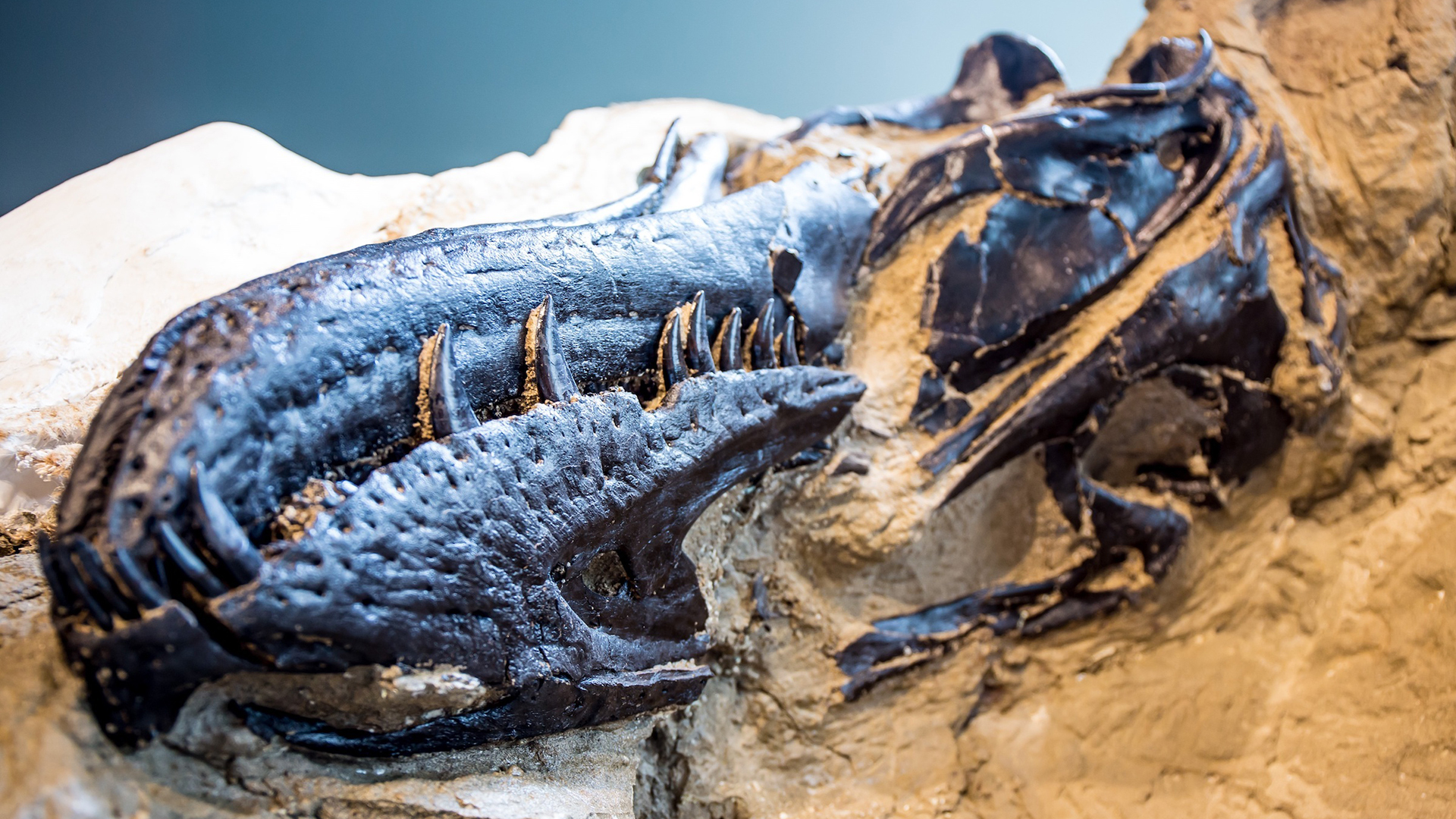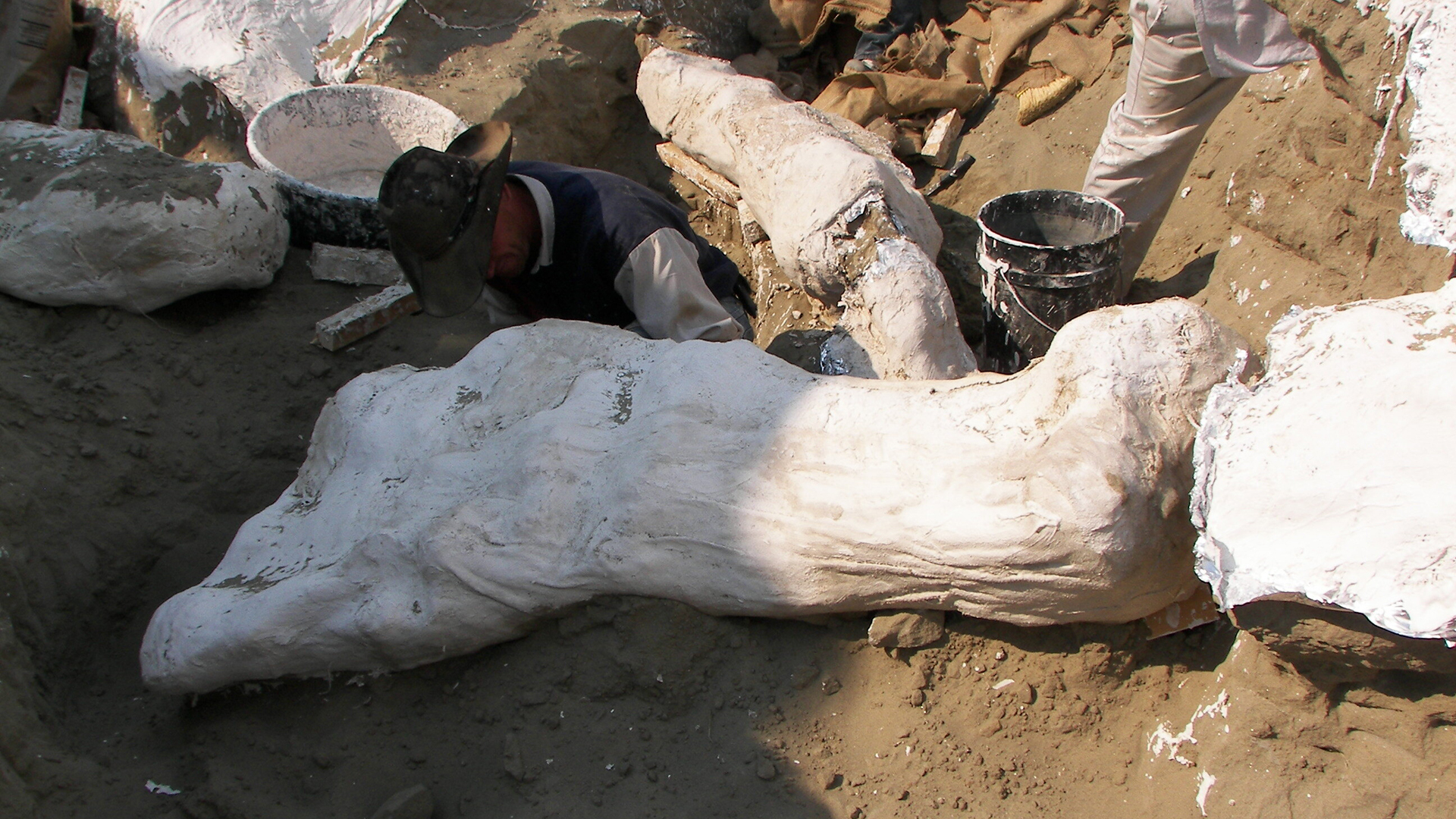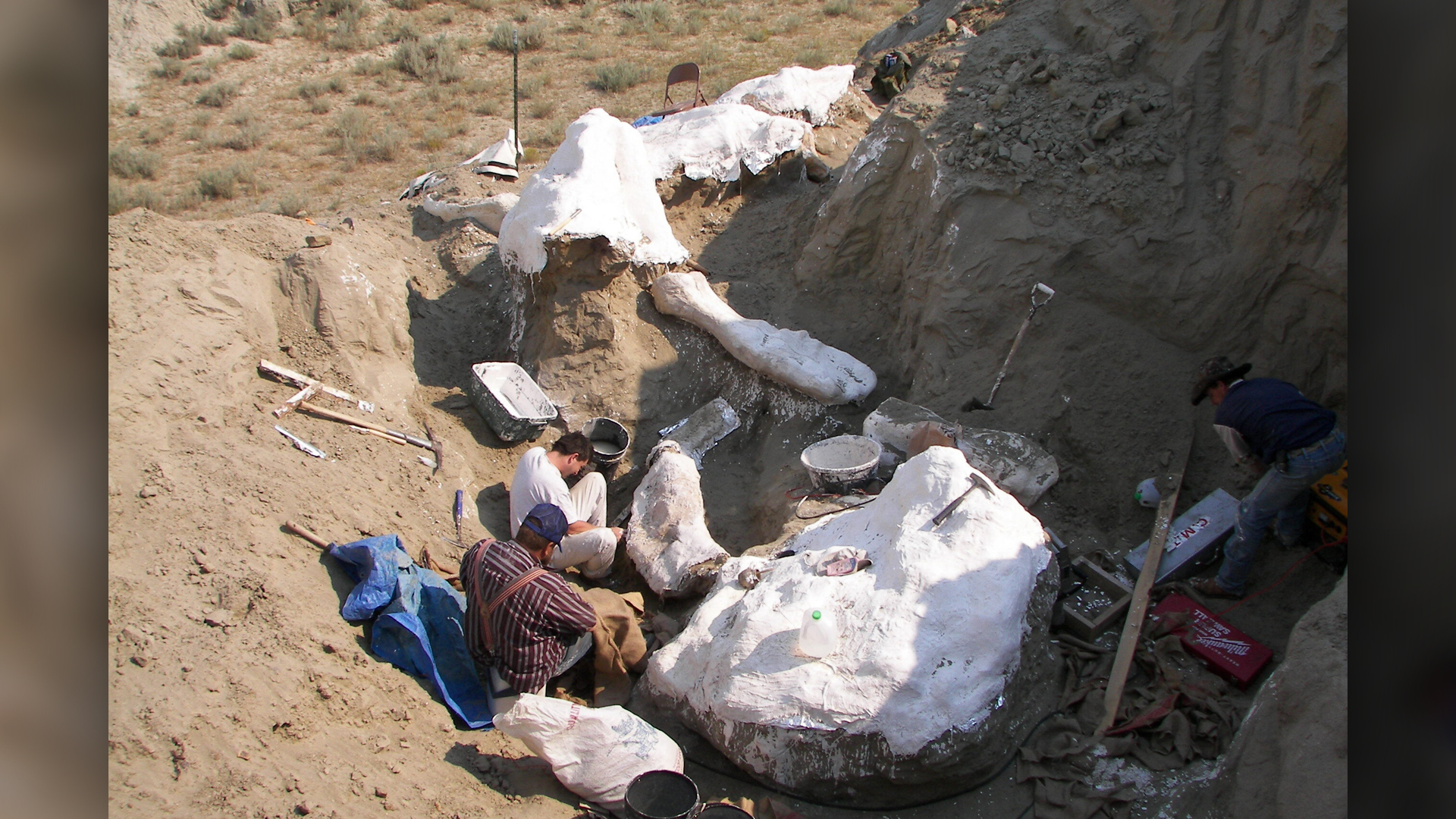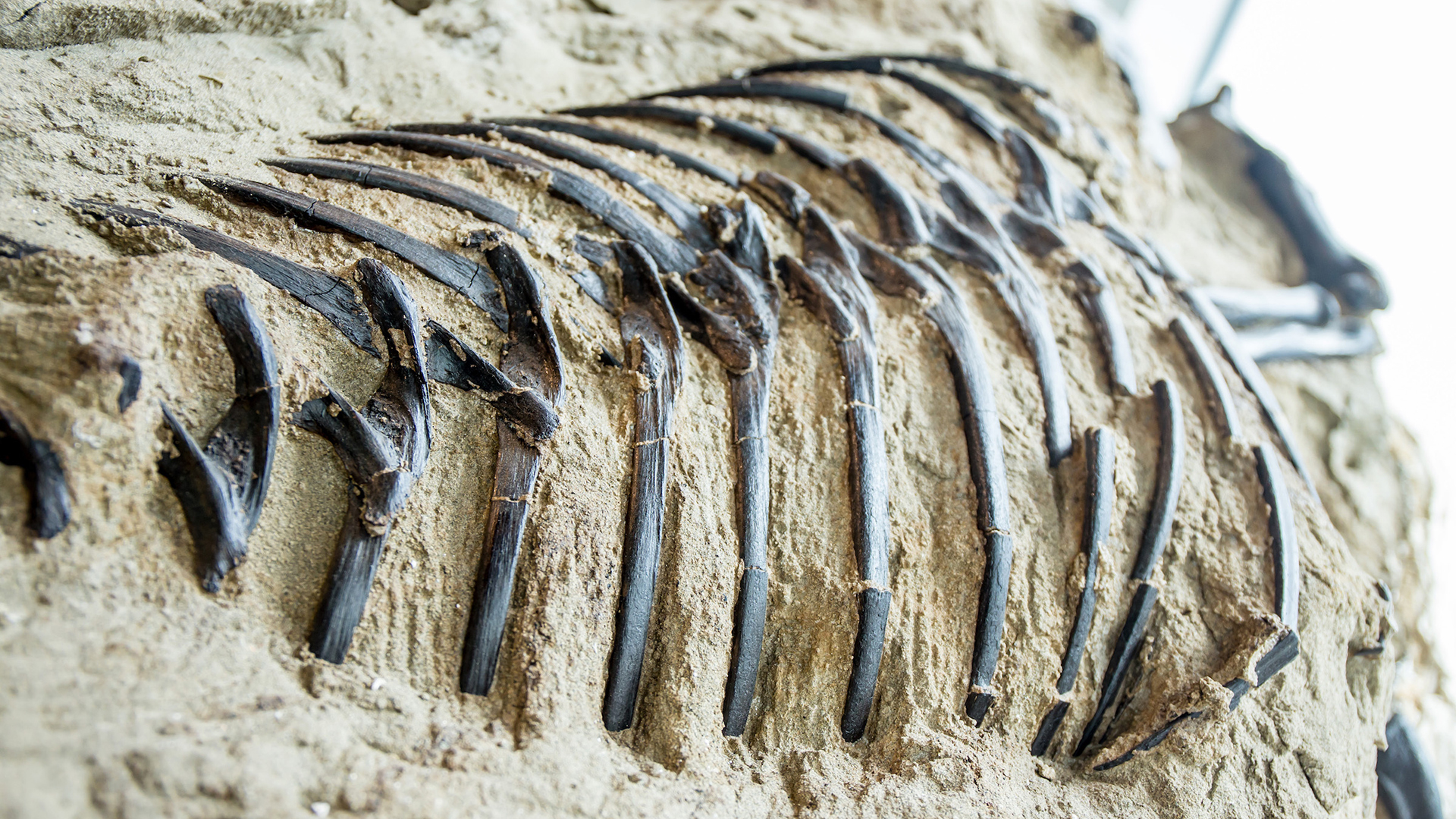Cretaceous cold case of 'dueling' T. rex and Triceratops may finally be solved
The fossils have gone through a failed auction and giant lawsuit.

The "Dueling Dinosaurs" fossils — the 67 million-year-old remains of what may be the most complete Tyrannosaurus rex and Triceratops on record, beasts that were possibly locked in combat when they died — are finally spilling their secrets. The iconic fossils are heading to the North Carolina Museum of Natural Sciences (NCMNS), where a cutting-edge interactive exhibit will be built around them, the museum announced today (Nov. 17).
The fossils are steeped in controversy. They're remarkable specimens, thought to include 100% of both creatures' bones, as well as body outlines, skin impressions and possibly even the remains of soft tissues and stomach contents. But after their discovery by commercial collectors in eastern Montana in 2006, the dinosaurs failed to sell at auction and were later involved in a lawsuit that attempted to redefine fossils as minerals. And the scientific community was torn about the fossils; many were excited to learn about the dinosaurs, but some said they were scientifically useless and others disliked that they were being sold by for-profit collectors.
Now, after a tremendous fundraising project, the 30,000-lbs. (13,600 kilograms) fossilized chunks holding the Dueling Dinosaurs have arrived in North Carolina, where scientists plan to study them before the public's eyes. And the duelers definitely aren't "scientifically useless," said Lindsay Zanno, head of paleontology at NCMNS and associate research professor at North Carolina State University, who spearheaded the project to bring the fossils to the museum.
Related: In photos: Montana's Dueling Dinosaur fossils
"What is remarkable about these specimens is they still preserve all their context" about the late Cretaceous period surroundings, Zanno told Live Science. "So we can really dive in and know there is integrity in the scientific data that will come from these specimens."

Dueling Dinosaur discovery
The Dueling Dinosaurs were discovered by Clayton Phipps, his cousin Chad O’Connor and his friend Mark Eatman. Clayton, as seen on the Discovery Channel show "Dino Hunters," is a cowboy, but "I prospect for dinosaurs on my horse now more than I ever look for cows," he joked.
In June 2006, the three went prospecting for dinosaurs and found an herbivore's pelvis weathering out of a hill. Phipps and Eatman weren't too excited, but O’Connor was fascinated, so they agreed to follow up. Phipps got permission from the landowners to dig there and returned with a crew about a month later. That's when he realized the site held far more than a pelvis; it held an entire tri-horned ceratopsian dinosaur and tyrannosaurus, side-by-side.
Get the world’s most fascinating discoveries delivered straight to your inbox.
"Here we have this world-class ceratopsian skeleton. It appears to be 100% complete from what we have exposed at that point. And now we have a meat-eating dinosaur — obviously they weren't friends," Phipps told Live Science. "What the heck's going on? I had to sit down and take it all in for a second."

Were these paleo-beasts fighting when catastrophe struck, entombing them together? Were they strangers with randomly neighboring burials? Only a full excavation of the skeletons may solve this mystery, for instance by finding whether the T. rex's teeth are embedded in the Triceratops' body.
The horned dinosaur is likely a Triceratops horridus, although that still needs to be confirmed, Zanno said. The tyrannosaur, however, has potential to be a Nanotyrannus, a controversial species that may or may not exist. Several studies suggest that Nanotyrannus is a juvenile T. rex, not a separate species. But "assuming that the science is correct at the moment and this specimen does in fact belong to a juvenile T. rex, then we are going to be the only museum in the world that has a 100% complete specimen of the tyrant king," Zanno said.
Related: Photos: Newfound tyrannosaur had nearly 3-inch-long teeth

Jack Horner, the paleontologist who served as technical advisor to the "Jurassic Park" movies and who originally called the Dueling Dinosaurs "scientifically useless" in an interview with Smithsonian Magazine, has since changed his mind upon learning that Zanno had access to the Montana excavation site, which provides critical context. "Now it is scientifically worth something," Horner told Live Science.

Failed auction, lost lawsuit
Once the fossils were out of the ground, Phipps couldn't find an institution interested in paying for them. So, when Bonhams auction house contacted him, Phipps reluctantly agreed. He wanted the fossils to go to science, but he also needed money to pay the landowners and for the team’s labor, he said. The 2013 auction was an enormous undertaking: The fossils were sent to New York and appraised for between $7 million and $9 million. But bidding reached only $5.5 million, so the specimens failed to sell.
Meanwhile, the landowners, Mary Anne and Lige Murray, were sued by the two brothers who had sold them the land. The brothers, Jerry and Robert Severson, retained mineral rights to land, and argued that the fossils were minerals and therefore belonged to them, according to Science magazine. After several trials and appeals, the brothers lost that case.

Welcome to the museum
Most museums don't have millions of dollars to spend on fossils. In this case, the nonprofit organization Friends of the North Carolina Museum of Natural Sciences raised private funds to buy the $6 million Dueling Dinosaurs from the three discoverers, landowners and excavators, and then the nonprofit donated the specimens to the museum.
The exhibit will be one-of a kind; museum visitors will be able to wander into a new laboratory known as DinoLab, where they can talk with researchers and see the fossils and tools up close. Live streams will show the research, Zanno said. In a public lab next door, visitors can try their hand at paleontology tools, techniques and technologies similar to those being done just a few feet away.
A $1 million donation from the Bank of America Foundation is enabling "Cretaceous Creatures," a project in which high-school students around the country and ultimately the world can dig through sediment collected from the Dueling Dinosaur site at the Hell Creek formation, so researchers can learn more about the microfossils there.
Related: Photos: Oldest known horned dinosaur in North America

Zanno's team plans to have the specimens CT scanned, so they can create digital 3D images of the dinosaurs' remains. They'll look for preservation of any soft tissues or proteins and analyze the fossils for evidence of diseases and wounds. The specimens have the only known preserved skin impressions from a Triceratops' frill and a possible T. rex's feet.
Regarding the frill, "that's going to be cool to answer some questions about what the covering was like on the face," Andrew Farke, curator and director of research and collections at the Raymond M. Alf Museum of Paleontology at The Webb Schools in California, who is not involved with the dueling dinosaurs, told Live Science. "There's been speculation that it was maybe entirely covered with keratin, so think of Triceratops as like a giant fingernail. Or maybe it was more a scaly kind of thing. I think [the dueling dinosaur is] going to be big for answering that question."
Construction for the DinoLab is set to open in 2021. Once it's open, visitors will be able to go into the lab as scientists conserve the dinosaurs, which will take about five years, and study their remains, Zanno said.
Originally published on Live Science.

Laura is the managing editor at Live Science. She also runs the archaeology section and the Life's Little Mysteries series. Her work has appeared in The New York Times, Scholastic, Popular Science and Spectrum, a site on autism research. She has won multiple awards from the Society of Professional Journalists and the Washington Newspaper Publishers Association for her reporting at a weekly newspaper near Seattle. Laura holds a bachelor's degree in English literature and psychology from Washington University in St. Louis and a master's degree in science writing from NYU.


